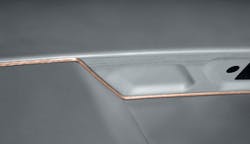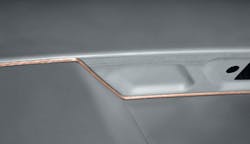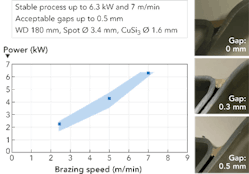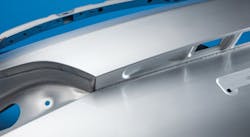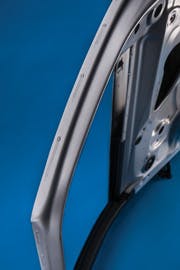Several car generations later, still a good choice
by Axel Luft
Twelve years ago, a Laserline diode laser was used for the first time in automotive body-in-white (BIW) series production. This initial application was the brazing of the tailgate of the Audi A3. Last year, the latest generation Audi A3 was launched.
Performance review
Let's review how diode lasers performed in their automotive applications over the last decade, in particular when a car model generation change occurs. The most common application is still brazing: within the current manufacturing process of the Audi A3, diode lasers are still used to braze the tailgate and the roof.
Today, Laserline offers a wide range of power levels and beam qualities. Since 2009, the product portfolio includes lasers with 4 kW output power in conjunction with a beam quality of 30 mm/mrad. This type of diode laser is comparable to lamp-pumped Nd:YAG lasers, which first enabled these applications. Today, diode lasers are used not only in brazing but also in welding and cutting BIW applications. In addition, the number of customers has increased dramatically, with all main automotive manufacturers using diode lasers. These developments have led to a large number of lasers used in series production. Currently, ~400 lasers are in operation worldwide in these types of applications, and overall close to 2000 have been installed since Laserline was founded in 1997.
Drivers for lasers in BIW production
Laser joining has many advantages compared to conventional joining methods like resistance spot welding or arc welding. Certainly every technology has its field, but laser joining has advantages such as small heat input, accessibility only from one side, high speed, and stable reproducible processes. These advantages contribute to the manufacturing of automobiles and especially BIW designs and production because weight is reduced and design choices are increased. Although these advantages are important, the main challenge of today's car design is still improving fuel consumption [corporate average fuel economy (CAFE standards)]. Of course, cost savings are also a driver for the use of laser technology.
Laser welding enables narrow seams, allowing the use of shorter flanges compared to spot welding. Shorter flanges have advantages. When used, for example, in door halos or A-pillars, the improvements are reduced weight and a better viewing angle out of the car. Today, there is more substitution of zinc-coated steel with aluminum, a change that places special demands on joining technologies. Because of the very high conductivity, resistance spot welding is not the optimum choice. In addition, aluminum is not as easy to draw in deep drawing tools, so the demand for more parts and therefore more joints arise as a result. Typically these joints are made by laser welding, clinching, riveting, flow drill screwing, MIG welding, and structural bonding. Laser joining opens design possibilities, which results in a more aesthetically pleasing external appearance.
Diode lasers offer a unique joining technology when applied to laser brazing of zinc-coated steel or laser welding of aluminum in the outer skin. In both cases, two outer skin parts can be joined by brazing or welding with a filler wire. Afterward, the seam is tight and has a smooth surface so the part can be painted directly after joining. This joining technology improves the appearance of a car and reduces the manufacturing cost by eliminating plastic covers, leading to savings in the assembly process and in logistics. Audi claimed a saving of 10 euro per car in the roof brazing application [2].
Brazing
Outer skin applications, such as tailgate or roof joints, are typical choices for the first major application of diode lasers: brazing. Spot diameters between 2 and 4 mm are required, and typical power levels are 3 to 4 kW for tailgates and 4 to 5 kW for roofs due to the demand for higher speeds. The tailgate brazing seam of the Audi A3 2001 is shown in FIGURE 1. Several Laserline lasers cover all the requirements, as mentioned above. They deliver a moderate beam quality with a 1000 µm diameter fiber and a numerical aperture of 0.22. They have a wall-plug efficiency of 45% and are more economical compared to other lasers. CuSi3 filler wire with 1 to 1.6 mm diameter is used. Roof joint lab results are shown in FIGURE 2. FIGURE 3 shows the roof brazing seal of the Audi A3 2012 in more detail.
In feasibility trials in the Laserline lab, brazing speeds for the roof joint were investigated. By using a 6.3 kW diode laser and a Scansonic ALO3 brazing optic, a brazing speed of 7 m/min with 6.3 kW was achieved in linear trials. Typically in series production, maximum speeds are between 4 and 5 m/min. For example, Volkswagen published a maximum speed of 4.4 m/min [3]. At Laserline, gaps of up to 0.5 mm were bridged. However, gaps should be avoided to keep a smooth and homogeneous seam geometry The majority of diode lasers in automotive production are installed in brazing applications around the world.
Welding
The second major diode laser application is aluminum welding (see FIGURES 4 and 5). During the last four years, several dozen lasers have been installed for such applications. Standard diode lasers today have 4 to 6 kW output powers, such as those used in Laserline systems. Typically, these lasers are used in conjunction with Scansonic AlO3 welding optics, which offers several special aluminum options. AlSi-based filler wire and argon shield gas are employed. The filler wire is needed to avoid hot cracks and to achieve similar results to brazing zinc-coated steel in outer skin applications. Typical wire diameters are 1.2 and 1.6 mm. Aluminum causes high back reflections during the welding process. However, unlike other laser technologies, diode lasers are insensitive to back reflection and thus there is no influence on the welding process.
The clamping device and the application is very similar to brazing. In using aluminum, the spot size has to be small; a diameter of 0.6 to 0.9 mm is required to penetrate the aluminum surface and to achieve a keyhole welding process. Aluminum welding is also often used in structure applications.
On the tailgate of a US car, there is an edge weld applied between the structure and outer panel. This weld has to be invisible from the outside. After processing, the car can be painted without any rework. In this case, the edge weld has a very small defined penetration depth.
The inner structure and outer skin of the car door are completely made out of aluminum. The door halo has short flanges and is welded with laser stitch welds. The inner structure is made up of two pieces. As mentioned, the depth of the structure is too deep to be drawn in one piece with deep drawing tools in the press shop. Therefore, both parts are welded again with laser stitch welds and later on covered by sealers. The example of the car door halo shows short flanges in aluminum. The same application is also done with keyhole welding in zinc-coated steel. Other examples are the door egress, covered roof joints, and A-pillars.
Cutting
Cutting has not been mentioned so far as a driver for lasers in BIW production because it seldom occurs there. One example of its use, however, is if holes for special derivates were not done in the press shop. Typically, there is no need for maximum cutting speeds. It is more important to have good quality cuts and to have high enough speed to cut within the cycle time. Customers usually use diode lasers in cutting if they already use them in production for brazing or welding. In this case, they have only one type of laser for all applications.
Summary and outlook
Lasers are drivers to support lightweight designs in today's fuel efficient vehicles, allowing new design possibilities and cost savings in BIW production. Diode lasers are used in BIW applications such as brazing, welding of steel or aluminum, and cutting. They offer advantages in wall-plug efficiency and are very robust against back reflections in aluminum welding. They are also cost efficient, reliable and easy to handle if service is required. All these application possibilities and advantages have led to an increased number of diode lasers in BIW production. Approximately 400 Laserline lasers are installed worldwide in these applications, and the numbers are increasing rapidly. ✺
References
1. EALA 2013, Audi, Dr. Graudenz.
2. EALA 2006, Audi, C. Ebert.
3. EALA 2009, Volkswagen, Dr. Engelbrecht.
Dr. Axel Luft([email protected]) is manager application/sales automotive for Laserline GmbH, Mülheim-Kärlich, Germany
More Industrial Laser Solutions Current Issue Articles
More Industrial Laser Solutions Archives Issue Articles
